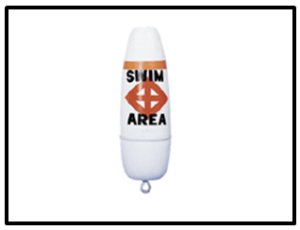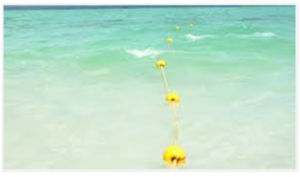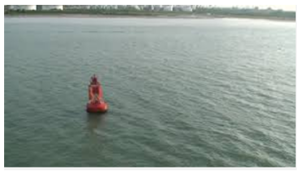 Swim Area Buoys – Channel Markers, On Lake Tahoe California, you’ll see the uniform system of buoys and markers that are standard throughout the United States. These buoys and markers are placed for your assistance and safety. In addition to written messages on the buoys, there are a variety of colors, shapes and symbols which aid in the recognition of a particular buoy. It’s a good idea to take some time and study the diagram showing how the buoys may be used.
Swim Area Buoys – Channel Markers, On Lake Tahoe California, you’ll see the uniform system of buoys and markers that are standard throughout the United States. These buoys and markers are placed for your assistance and safety. In addition to written messages on the buoys, there are a variety of colors, shapes and symbols which aid in the recognition of a particular buoy. It’s a good idea to take some time and study the diagram showing how the buoys may be used.
- Diver’s Flag: Must be used any time a diver is in the water. Boats must not come closer than 50 feet of the flag and must operate at a Slow-No Wake speed within 200 feet.
- Alpha Flag: Means a vessel is engaged in diving operations or is restricted in its ability to navigate. Boaters must use extreme caution and are advised to look for a diver’s-down flag.
- Mooring Buoys: Means an anchor buoy. This is the only buoy to which a boat may tie or secure to.
- Red Channel Marker Buoy: Traveling upstream, you should pass to the left of this buoy as it marks the right side of the channel.
- Green (or black) Channel Marker Buoy: Traveling upstream, you should pass to the right of this buoy as it marks the left side of the channel.
- Junction Buoy (RED OVER GREEN): means two channels are coming together and you pass to the left of the buoy as you travel upstream.
- Junction Buoy (GREEN OVER RED): means two channels are coming together and you should pass to the right of the buoy as you travel upstream.
- Boats Keep Out Buoy: Marks a swimming area, area near a dam, or any area where boats are not allowed.
- Danger Buoy: Marks an obstruction, ferry cable, or any area where boats should not navigate or should use extreme caution.
- Information Buoy: Used to relay information. Words printed in black (usually inside the border) tell place names, distances, directional arrows, availability of supplies, gasoline, etc.
- Control Buoy: Marks a restricted area such as “slow-no wake,” 5 MPH, no skiing or no fishing.
- Passing Daymark (RED): A sign mounted on poles in the water or on the bank which is used in the same manner as a channel marker buoy. In this case it marks the right side of the channel as you travel upstream.
- Passing Daymark (GREEN): A sign mounted on poles in the water or on the bank which is used in the same manner as a channel marker buoy. In this case it marks the left side of the channel as you travel upstream.
- Channel Crossing Daymark (RED): A sign mounted on poles in the water or on the bank which means the channel is crossing from the right bank to the left bank as you travel upstream.
- Channel Crossing Daymark (GREEN): A sign mounted on poles in the water or on the bank which means the channel is crossing from the left bank to the right bank as you travel upstream.
 To know this or the way how can use the Swim area marker buoys is important because each one of them indicates relevant or necessary information to help you at be safe. There are a variety of things we can use to find our way around on the water. Known landmarks such as the mouth of a river or an island certainly help. In addition to these natural landmarks we have lighthouses, buoys, and beacons known collectively as aids to navigation or ATON for short.
To know this or the way how can use the Swim area marker buoys is important because each one of them indicates relevant or necessary information to help you at be safe. There are a variety of things we can use to find our way around on the water. Known landmarks such as the mouth of a river or an island certainly help. In addition to these natural landmarks we have lighthouses, buoys, and beacons known collectively as aids to navigation or ATON for short.
Other areas of concern that have been presented include the use of buoys to mark off swimming areas, temporary structures and operation of personal watercraft. Current regulations require a permit to place temporary structures; buoys or signs and Current statute and regulations provide the following for each:
In the case of the marking of legally designated swimming areas, we have the next:
 Individual private areas.
Individual private areas.
The owner or lessee of shoreline property may place white markers defining a swimming area adjacent to the property for personal use. This area shall not exceed 2,500 square feet in area and shall not extend more than 50 linear feet along the lake frontage of the owner or lessee. These markers must have no less than six inches but no more than 14 inches showing above the waterline.
Markers in the form of a cylinder must have a diameter of at least five inches and not larger than nine inches. Markers with a shape other than a cylinder may not have a length or width greater than 14 inches. Each such marker shall bear on opposite sides a one-half inch wide band of international orange color forming an upright diamond at least five inches in outside width, dissected vertically and horizontally by a one-half inch wide strip of international orange color. The border of the diamond and cross outline shall not be less than one-half inch in width. These markers may not be spaced more than 15 feet apart and must outline all of the swimming area.
 No swimming marker may obstruct watercraft traffic or unduly interfere with public use of the water. If in the opinion of the local sheriff, the sheriff’s water patrol officer, or conservation officer, such conditions exist, they may direct the landowner or lessee to change the boundaries of the swimming area or have the markers removed. The landowner or lessee may appeal such a directive to the commissioner of natural resources.
No swimming marker may obstruct watercraft traffic or unduly interfere with public use of the water. If in the opinion of the local sheriff, the sheriff’s water patrol officer, or conservation officer, such conditions exist, they may direct the landowner or lessee to change the boundaries of the swimming area or have the markers removed. The landowner or lessee may appeal such a directive to the commissioner of natural resources.
The US government and Enforcement departments to ensure the safety seaway direction have created a series of regulations and in this case about marker buoys in the pool area Lake Tahoe California. For that the Recreonics Company located in Lake Tahoe California is serving customers for many years providing quality products for everything related to installation of buoys and channel markers at the best market price and a few meters from the complex Lake Tahoe.
 Understanding the waterway marking systems is important, as these markers will identify safe waters, convey important information to the skipper, and assist in navigation.
Understanding the waterway marking systems is important, as these markers will identify safe waters, convey important information to the skipper, and assist in navigation.